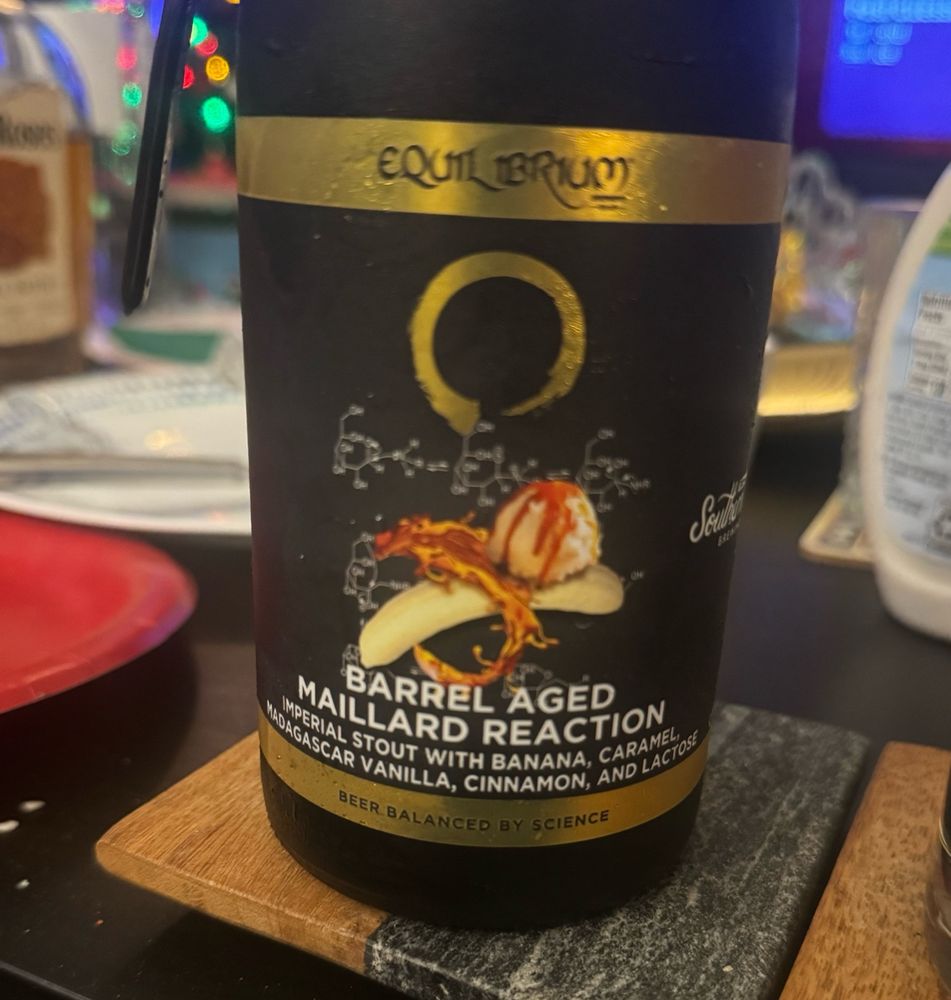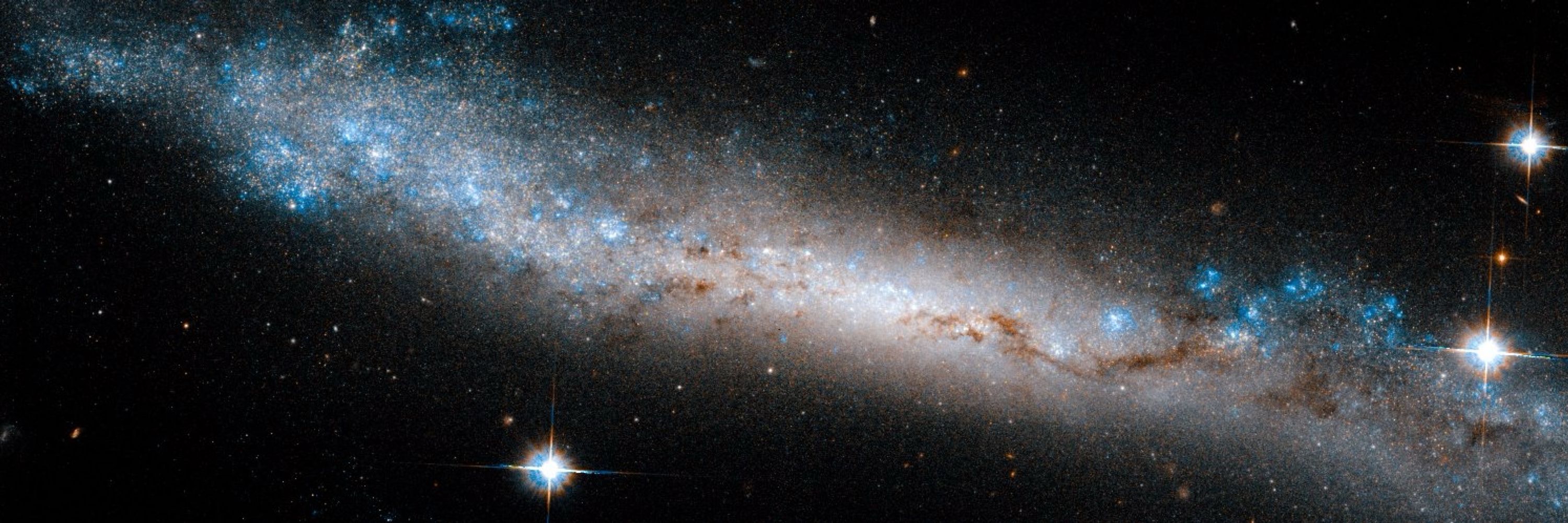
Dr. Deep Anand
@styrofoamplates.bsky.social
some guy working on some telescope. views are my own and not those of my employer or the government or anyone else.
> gets new tires last week after putting it off for a while
> driving out today on brand new tires… 😭
> driving out today on brand new tires… 😭
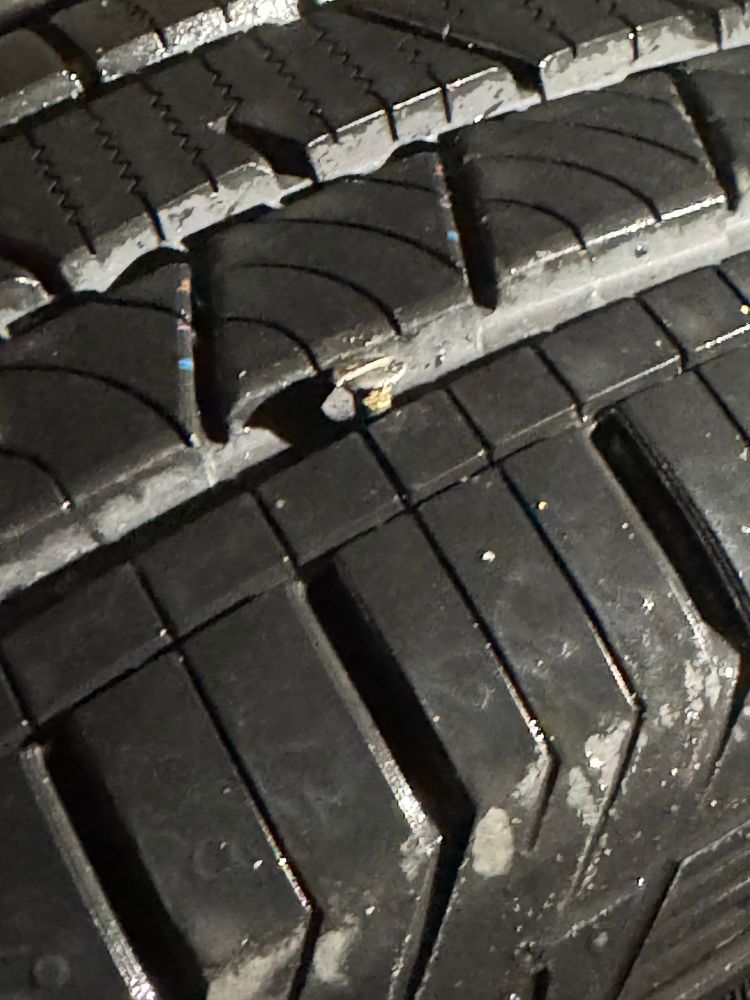
December 28, 2024 at 11:50 PM
> gets new tires last week after putting it off for a while
> driving out today on brand new tires… 😭
> driving out today on brand new tires… 😭
next observing stop for our group is the Coma cluster, where we will fully calibrate the SBF method with JWST filters, in preparation for measurements of SBF well out into the Hubble flow.
in the end, we will finally put the Hubble tension to rest (one way or the other).
in the end, we will finally put the Hubble tension to rest (one way or the other).

September 3, 2024 at 4:45 PM
next observing stop for our group is the Coma cluster, where we will fully calibrate the SBF method with JWST filters, in preparation for measurements of SBF well out into the Hubble flow.
in the end, we will finally put the Hubble tension to rest (one way or the other).
in the end, we will finally put the Hubble tension to rest (one way or the other).
JWST is an absolute powerhouse.
our color-magnitude diagrams are some of the deepest ever for galaxies within Virgo. these CMDs allow us to measure very precise TRGB distances.
our color-magnitude diagrams are some of the deepest ever for galaxies within Virgo. these CMDs allow us to measure very precise TRGB distances.
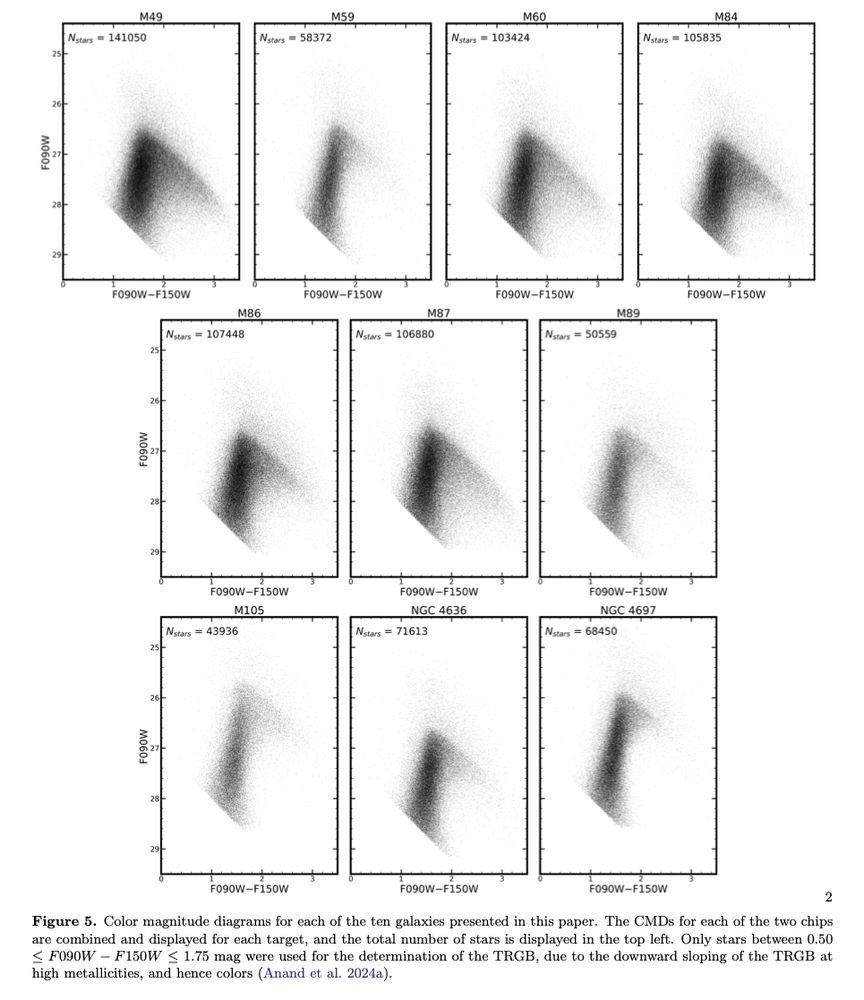
September 3, 2024 at 4:44 PM
JWST is an absolute powerhouse.
our color-magnitude diagrams are some of the deepest ever for galaxies within Virgo. these CMDs allow us to measure very precise TRGB distances.
our color-magnitude diagrams are some of the deepest ever for galaxies within Virgo. these CMDs allow us to measure very precise TRGB distances.
the extended spatial coverage of NIRCam allows us to obtain imaging that is well suited for both TRGB and SBF measurements, in the same pointing.

September 3, 2024 at 4:43 PM
the extended spatial coverage of NIRCam allows us to obtain imaging that is well suited for both TRGB and SBF measurements, in the same pointing.
in this paper we focus on TRGB distances to ten galaxies in and around the nearby Virgo cluster.

September 3, 2024 at 4:43 PM
in this paper we focus on TRGB distances to ten galaxies in and around the nearby Virgo cluster.
excited to share ongoing results from the TRGB-SBF Project, where we aim to resolve the Hubble tension with a distance ladder which is independent of the usual Cepheid+Type Ia supernova route!
🔭🧪
arxiv.org/abs/2408.16810
🔭🧪
arxiv.org/abs/2408.16810

September 3, 2024 at 4:42 PM
excited to share ongoing results from the TRGB-SBF Project, where we aim to resolve the Hubble tension with a distance ladder which is independent of the usual Cepheid+Type Ia supernova route!
🔭🧪
arxiv.org/abs/2408.16810
🔭🧪
arxiv.org/abs/2408.16810
again, at this point we do not seem to be arguing about distances for the most part– we take their distances at face value and find HST Cepheid distances as well as all other methods are very consistent with the existence of a Hubble tension.

August 22, 2024 at 2:29 PM
again, at this point we do not seem to be arguing about distances for the most part– we take their distances at face value and find HST Cepheid distances as well as all other methods are very consistent with the existence of a Hubble tension.
if you take that detail into account and join samples of JWST distances (CCHP and SH0ES), which by the way both agree with HST Cepheids extremely well, we find that this is how the game turns outs.

August 22, 2024 at 2:27 PM
if you take that detail into account and join samples of JWST distances (CCHP and SH0ES), which by the way both agree with HST Cepheids extremely well, we find that this is how the game turns outs.
the CCHP H0 plot here is also simply *not* correct, because it makes the incorrect assumption that these three underlying PDFs are independent. but they share the same (very small) sample of supernovae. you have to take this into account!!

August 22, 2024 at 2:25 PM
the CCHP H0 plot here is also simply *not* correct, because it makes the incorrect assumption that these three underlying PDFs are independent. but they share the same (very small) sample of supernovae. you have to take this into account!!
hey everyone, if you're interested in the Hubble Tension, *please* see this paper we just put out.
🔭 🧪
arxiv.org/abs/2408.11770
🔭 🧪
arxiv.org/abs/2408.11770

August 22, 2024 at 2:18 PM
hey everyone, if you're interested in the Hubble Tension, *please* see this paper we just put out.
🔭 🧪
arxiv.org/abs/2408.11770
🔭 🧪
arxiv.org/abs/2408.11770
Here’s the key plot btw. There is incredible agreement on the galaxy distances themselves between the different techniques (cepheids, trgb, jagb). The differences in H0 are just a result of the small and skewed supernovae subsamples! 🧪🔭
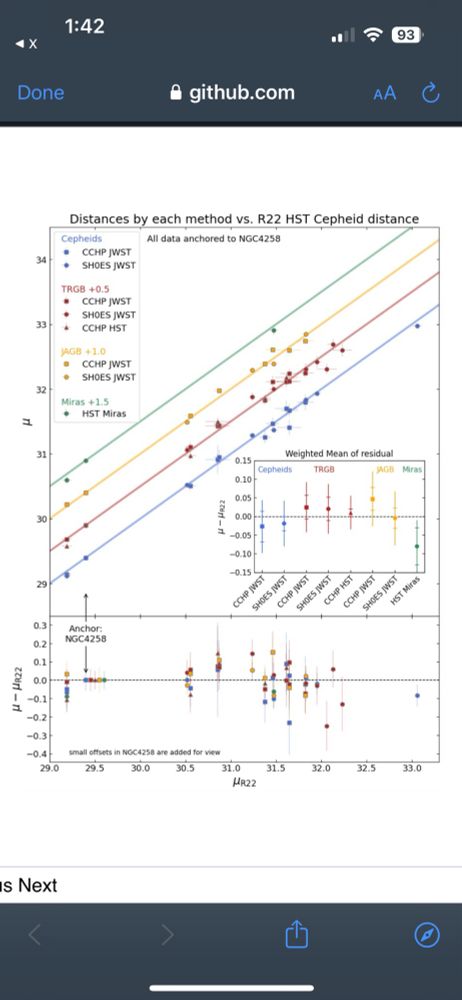
August 13, 2024 at 5:44 PM
Here’s the key plot btw. There is incredible agreement on the galaxy distances themselves between the different techniques (cepheids, trgb, jagb). The differences in H0 are just a result of the small and skewed supernovae subsamples! 🧪🔭
Also because they are all <1 sigma of HST Cepheids, all the crosschecks pass so there’s no reason to not use the much larger 42 SN Ia H0 which gives the most precise H0. This is awesome
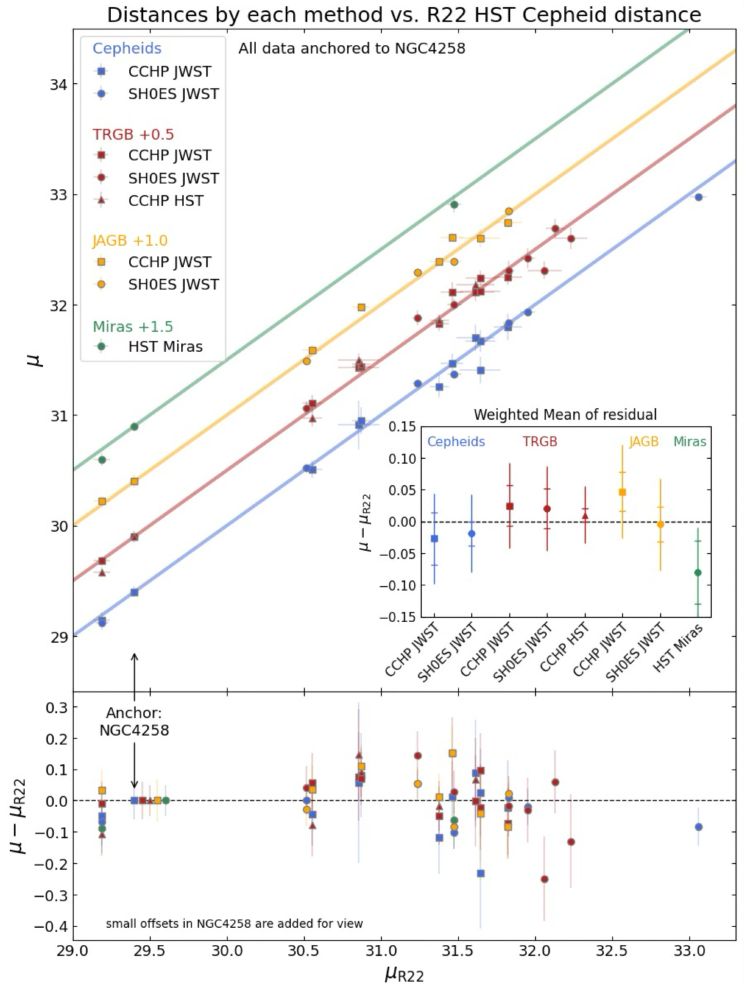
August 13, 2024 at 5:26 PM
Also because they are all <1 sigma of HST Cepheids, all the crosschecks pass so there’s no reason to not use the much larger 42 SN Ia H0 which gives the most precise H0. This is awesome
Stealing this slide from Dan Scolnic over on twitter, but a lot of the difference is due to the small subsample probed (1/4 geometric anchors and 7/42 SN hosts)

August 9, 2024 at 8:24 PM
Stealing this slide from Dan Scolnic over on twitter, but a lot of the difference is due to the small subsample probed (1/4 geometric anchors and 7/42 SN hosts)
we use well defined methods for measuring the TRGB, and we do so in F090W (~I-band), where the TRGB feature is very stable as a function of metallicity and age, unlike redder filters where its slope becomes difficult to pin down.
you can clearly point it out, by eye even!
you can clearly point it out, by eye even!
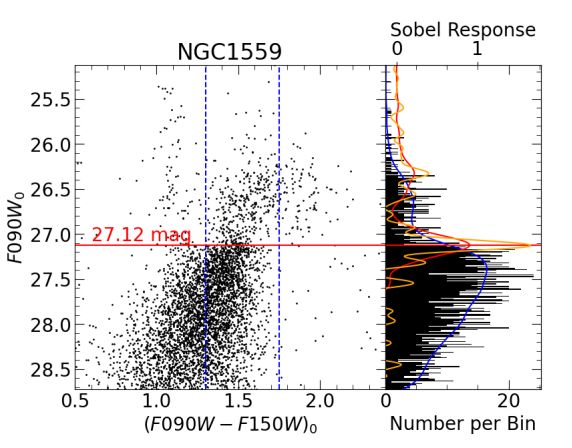
August 2, 2024 at 3:40 PM
we use well defined methods for measuring the TRGB, and we do so in F090W (~I-band), where the TRGB feature is very stable as a function of metallicity and age, unlike redder filters where its slope becomes difficult to pin down.
you can clearly point it out, by eye even!
you can clearly point it out, by eye even!
really, we see no evidence for disagreement between the two methods. there's some chatter recently about other, in-progress work, but here's a paper, with photometry to be made public upon publication.
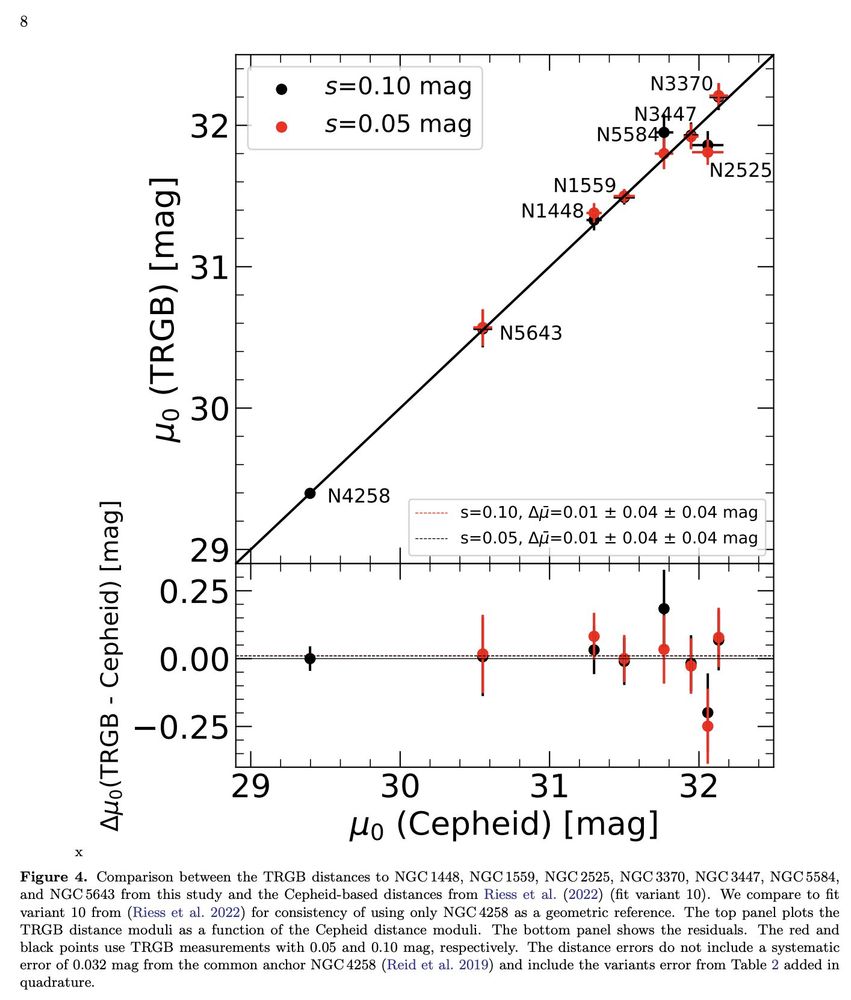
August 2, 2024 at 3:39 PM
really, we see no evidence for disagreement between the two methods. there's some chatter recently about other, in-progress work, but here's a paper, with photometry to be made public upon publication.
hey all, please check out new paper led by JHU grad student Sean Li on JWST and the distance scale!
in short, the JWST TRGB and HST (and JWST) Cepheid distance scales are in near-perfect agreement, and the Hubble tension absolutely persists.
arxiv.org/abs/2408.00065
🔭🧪
in short, the JWST TRGB and HST (and JWST) Cepheid distance scales are in near-perfect agreement, and the Hubble tension absolutely persists.
arxiv.org/abs/2408.00065
🔭🧪

August 2, 2024 at 3:37 PM
hey all, please check out new paper led by JHU grad student Sean Li on JWST and the distance scale!
in short, the JWST TRGB and HST (and JWST) Cepheid distance scales are in near-perfect agreement, and the Hubble tension absolutely persists.
arxiv.org/abs/2408.00065
🔭🧪
in short, the JWST TRGB and HST (and JWST) Cepheid distance scales are in near-perfect agreement, and the Hubble tension absolutely persists.
arxiv.org/abs/2408.00065
🔭🧪
the SBF signal in the same images is astoundingly high, with S/N~250. once the zero-point is established with this program, and metallicity/age effects are calibrated with our Cycle 3 program (GO–5989), we are looking to measure SBF distances out to ~300 Mpc, and then measure H0.
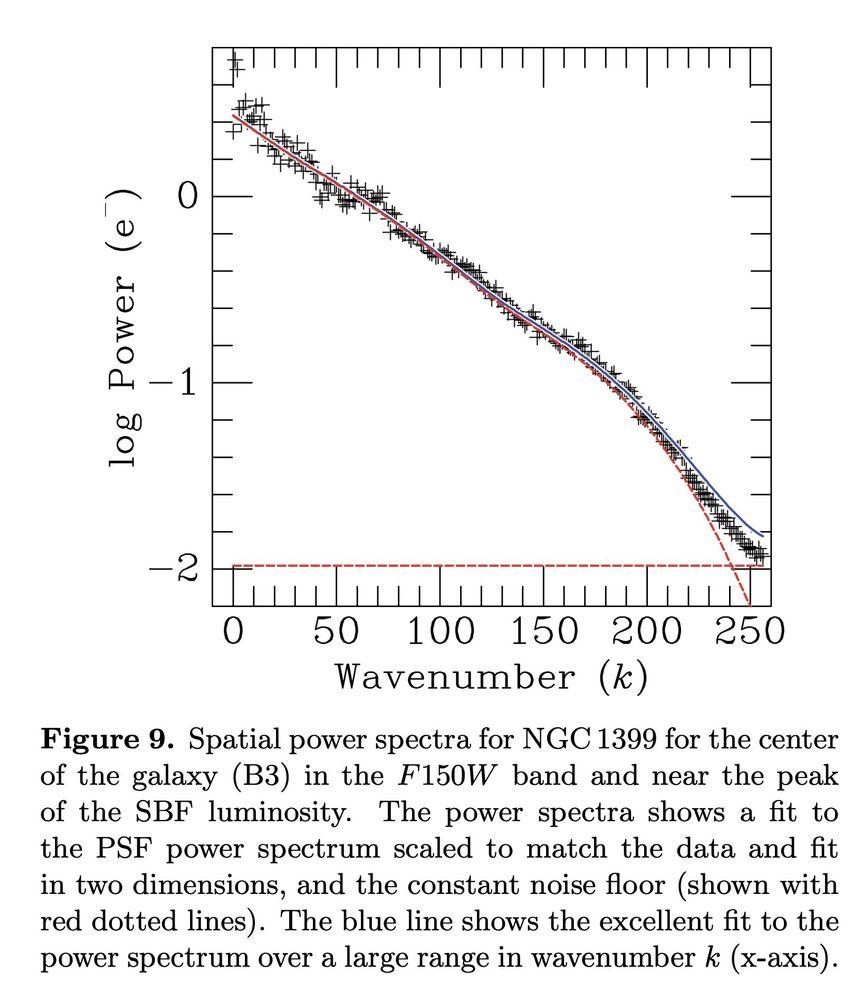
May 8, 2024 at 9:58 PM
the SBF signal in the same images is astoundingly high, with S/N~250. once the zero-point is established with this program, and metallicity/age effects are calibrated with our Cycle 3 program (GO–5989), we are looking to measure SBF distances out to ~300 Mpc, and then measure H0.
we measure ~3.5% distances to three early-type galaxies in the Fornax cluster. we have 11 more observations coming up in the next couple months (mainly in Virgo), after which we will be able to provide a robust zeropoint for future SBF measurements.

May 8, 2024 at 9:58 PM
we measure ~3.5% distances to three early-type galaxies in the Fornax cluster. we have 11 more observations coming up in the next couple months (mainly in Virgo), after which we will be able to provide a robust zeropoint for future SBF measurements.
the depth of our data is astounding. here's a comparison of a ~5 hour JWST pointing to a previous 34-orbit (~50 hour) HST dataset.
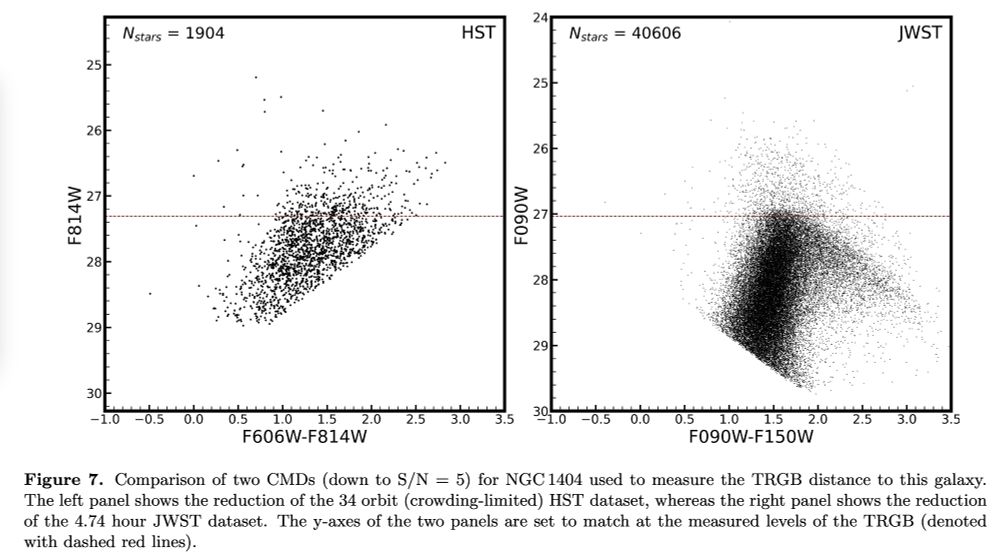
May 8, 2024 at 9:58 PM
the depth of our data is astounding. here's a comparison of a ~5 hour JWST pointing to a previous 34-orbit (~50 hour) HST dataset.
our Cycle 2 JWST program (GO–3055) is designed to allow TRGB and SBF measurements simultaneously, with one NIRCam module in the core (SBF), and another in the halo (TRGB).
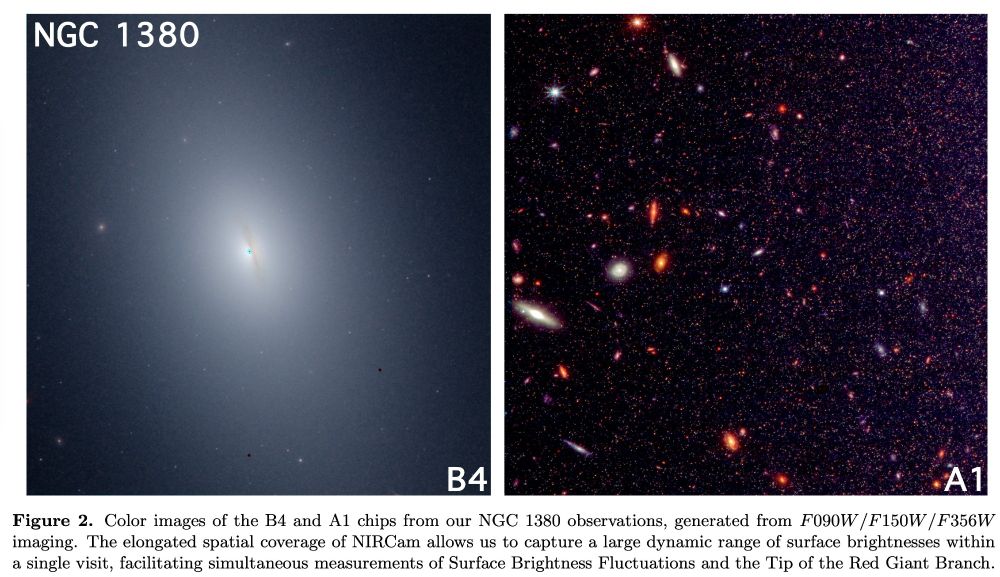
May 8, 2024 at 9:57 PM
our Cycle 2 JWST program (GO–3055) is designed to allow TRGB and SBF measurements simultaneously, with one NIRCam module in the core (SBF), and another in the halo (TRGB).
here we use Cycle 2 JWST data to measure the distance to 3 Fornax Cluster early-type galaxies, which are the first of 14 targets from our Cycle 2 program.

May 8, 2024 at 9:57 PM
here we use Cycle 2 JWST data to measure the distance to 3 Fornax Cluster early-type galaxies, which are the first of 14 targets from our Cycle 2 program.





